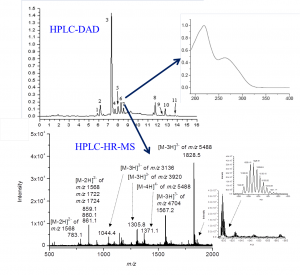Sometimes qualitative analysis of polyphenols is simple and typically the use of LC-assisted methods really simplifies the life of a phytochemist
 Some 25 years ago the life of a phytochemist was much more complicated than nowadays. Back then it was relatively rare to find LC-MS instruments in the lab and this meant that all the individual polyphenols needed to be first purified and only after that inspected for their MS spectra. This situation really slowed down the typical polyphenol identification processes, since even known compounds were accidentally isolated as their identities could not be verified before the isolation process by the use of LC-DAD instruments alone.
Some 25 years ago the life of a phytochemist was much more complicated than nowadays. Back then it was relatively rare to find LC-MS instruments in the lab and this meant that all the individual polyphenols needed to be first purified and only after that inspected for their MS spectra. This situation really slowed down the typical polyphenol identification processes, since even known compounds were accidentally isolated as their identities could not be verified before the isolation process by the use of LC-DAD instruments alone.
Today LC-assisted methods typically mean the utilization of both diode array (LC-DAD) and mass spectrometry (LC-MS) detectors. In fact, for polyphenol researcher it is not recommended to use LC instruments with UV detectors only as these cannot record the very informative UV spectra of polyphenols. Instead, LC is typically connected to both DAD and MS to simultaneously obtain UV and MS information of all the compounds that are first separated by chromatographic methods. The information thus gained should be sufficient to declare whether any of the detected compounds need to be purified for further inspection by e.g. CD and NMR. Here a wide knowledge of UV and MS spectra of polyphenols does not harm, since it makes no sense to reinvent the wheel and isolate a compound that we already know.
Some years ago the hyphenated combination of LC with NMR was under a lot of positive discussion as it might further decrease the need for time-consuming purification of polyphenols. However, these LC-NMR approaches have not quite yet reached such a routine operation limits as e.g. LC-MS that is currently considered almost a standard tool of any phytochemical laboratory.
Of the LC methods it is clear that modern UPLC (or UHPLC) instruments clearly are more efficient than the standard HPLC’s, although some HPLC manufacturers have developed their instruments to be able to handle column pressures up to 600 bar range. UPLC is able to operate at 1000-1200 bar range and this enables the use of new column chemistries with very narrow particle sizes down to 1.7 µm.
